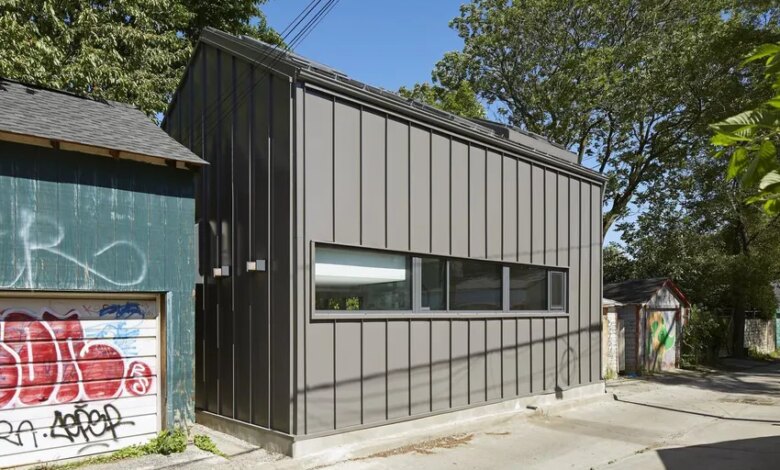The family-owned College Laneway House makes use of small space

When Toronto contractor Zeke Kaplan and his mother decided to embark on an avenue project, they wanted to create a suite for long-term tenants. Zeke’s sister lived in a detached house at the front of the property in the College and Bathurst area. The plan was to renovate the dilapidated ancient fisherman’s hut at the rear.
Kaplan, whose company ZZ Contracting built the house, explains, “We wanted to keep the footprint of the building and modify the roof to maximize interior space.”
They contacted LGA Architectural Partners and created a five-story, 1,500-square-foot split-level home. Architect Brock James of LGA explains: “Our goal was to explore how to make a small house on an avenue feel spacious.
“The design consists of a series of rooms rising, on five levels, from the basement to the second floor, each with its own proportion, unique relationship to the outside world and to each other.
“Within the compact footprint, this differentiation creates an illusion of spaciousness, making the home feel larger.”
Kaplan says durability was important: “The use of Douglas millwork throughout the interior was inspired by the original spruce cladding discovered when dismantling the existing structure. We carefully stripped, planed, milled and used that 100 year old plus Douglas fir to clad the front of the house.
A series of large glass doors span the length of the space and serve to fuse the inside with the outside. “Planted roofs outside the bedroom create a feeling of sleeping in a meadow,” says James.
Kaplan agrees. “There’s a certain amount of tranquility right in the center of Toronto, but completely immersed in the greenery in the backyard.”
Brock James, partner, LGA Architectural Partners, Toronto, explains how the project came about:
How did you get more light into your home? The open sides of the house face east and west. We have introduced windows on both facades, although these windows are limited due to the need for privacy. To really increase the amount of daylight, skylights are key; you can close all the blinds and still enjoy natural light. Through openings on both the east and west facade you have direct sunlight all day long.
What were the biggest challenges in designing and building the home? The biggest design challenge was to respect the existing volume of the former structure. As with many things, constraints often lead to interesting solutions.
The cramped location required creativity and collaboration for construction. Construction was staged to allow large elements to fit through unfinished skylights. Neighbors helped by granting access to their land in exchange for minor improvements to their property, gladly provided by the owner of the laneway.
How do you ensure privacy? Because avenue homes face other homes and are right next to laneways, privacy is an important consideration. The skylights are a great way to bring in natural lighting while controlling the view into the house. Windows are carefully placed and detailed to give residents control over their privacy. Bottom-up window blinds give residents control over the view inside. When the blinds are open, well-placed trees help protect the view, as does the green roof vegetation just outside the bedroom windows. On the track side, the strip window, just above the height of the head of the track, lets in the afternoon sun and frames the graffiti garage doors.
Do you see this as part of the housing solution in the future? Lane houses, like the College Laneway House, are a great, “light” way to grow the city within our established neighborhoods. Adding housing units in these neighborhoods leverages existing infrastructure, diversifies residents and enlivens the avenue spaces of our cities.

:format(webp)/https://www.thestar.com/content/dam/thestar/life/homes/review/2023/07/01/college-laneway-house-a-family-affair-that-transforms-small-space-into-expansive-home/b_college_laneway_house.jpg)
:format(webp)/https://www.thestar.com/content/dam/thestar/life/homes/review/2023/07/01/college-laneway-house-a-family-affair-that-transforms-small-space-into-expansive-home/c_college_laneway_house_inside5.jpg)
:format(webp)/https://www.thestar.com/content/dam/thestar/life/homes/review/2023/07/01/college-laneway-house-a-family-affair-that-transforms-small-space-into-expansive-home/d_college_laneway_house8.jpg)
:format(webp)/https://www.thestar.com/content/dam/thestar/life/homes/review/2023/07/01/college-laneway-house-a-family-affair-that-transforms-small-space-into-expansive-home/e_college_laneway_house_kitchen7.jpg)



